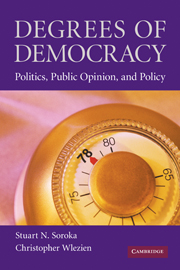Book contents
- Frontmatter
- Contents
- Preface
- Degrees of Democracy
- 1 Public Opinion and Policy in Representative Democracy
- 2 The Thermostatic Model
- 3 Adding Issues and Institutions
- 4 Public Preferences and Spending
- 5 Parameters of Public Responsiveness
- 6 Public Responsiveness Explored
- 7 Policy Representation
- 8 Disaggregating Public Responsiveness and Policy Representation
- 9 Degrees of Democracy
- Appendix
- Bibliography
- Index
Preface
Published online by Cambridge University Press: 05 June 2012
- Frontmatter
- Contents
- Preface
- Degrees of Democracy
- 1 Public Opinion and Policy in Representative Democracy
- 2 The Thermostatic Model
- 3 Adding Issues and Institutions
- 4 Public Preferences and Spending
- 5 Parameters of Public Responsiveness
- 6 Public Responsiveness Explored
- 7 Policy Representation
- 8 Disaggregating Public Responsiveness and Policy Representation
- 9 Degrees of Democracy
- Appendix
- Bibliography
- Index
Summary
This is a book about representative democracy. We are interested in seeing how well it works – specifically, how consistently governments make policy that reflects public preferences. There is a good deal of academic work demonstrating quite a strong connection between opinion and policy. Even as there seems to be representation, however, there seems to be little basis for it in the public itself. That is, even while showing that governments tend to follow preferences, the body of evidence suggests that the public is largely inattentive to politics, and uninterested and uninformed about the goings-on of governments.
The problem is that the representation of opinion presupposes that the public actually notices and responds to what policymakers do. Without such responsiveness, policymakers have little incentive to represent what the public wants in policy – there is no real benefit for doing so and no real cost for not doing so. Moreover, without public responsiveness to policy, expressed public preferences contain little meaningful information – they are unanchored to the policy status quo. As a result, there is not only a limited basis for holding politicians accountable, but expressed preferences also are of little use even to those politicians motivated to represent the public for other reasons. We need a responsive public; effective democracy depends on it.
A responsive public behaves much like a thermostat. It adjusts its preferences for “more” or “less” policy in response to what policymakers do. Imagine a situation in which the public prefers more defense policy.
- Type
- Chapter
- Information
- Degrees of DemocracyPolitics, Public Opinion, and Policy, pp. vii - xPublisher: Cambridge University PressPrint publication year: 2009

